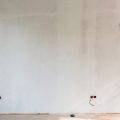1. Understanding Common Types of Drywall Damage
Drywall is a popular choice for interior walls and ceilings in most American homes because it’s affordable, easy to install, and smooth in appearance. But like any material, drywall can suffer from wear and tear over time. Understanding the common types of drywall damage can help you identify issues early and choose the right repair method.
Common Causes of Drywall Damage
There are several reasons why drywall might get damaged. Heres a quick overview:
| Cause | Description |
|---|---|
| Nail Pops | These occur when the nails or screws holding the drywall to the studs push out slightly, creating a small bump or hole in the wall surface. |
| Stress Cracks | Usually found near doors, windows, or corners where the house might shift slightly over time, causing hairline cracks in the drywall. |
| Impact Holes | These are caused by accidental force, like doorknobs hitting the wall, moving furniture, or rough play. |
| Water Damage | Leaks from plumbing or roofs can soak drywall, leading to soft spots, staining, or even mold growth. |
| Renovation Damage | When removing fixtures or changing layouts, parts of the drywall may be torn or broken. |
Nail Pops
Nail pops are small circular bumps that appear on walls or ceilings. Theyre usually caused by nails loosening due to wood contraction and expansion behind the drywall. While they dont typically affect structural integrity, they can be unsightly and may continue if not repaired correctly.
Stress Cracks
These thin cracks often show up near seams or corners and are a normal part of a home settling over time. They’re more common in new constructions as materials adjust to temperature and humidity changes.
Holes from Accidents or Renovations
Larger holes tend to come from physical impact—like kids playing rough indoors—or during renovations when items like shelves or cabinets are removed. These holes vary in size but are all fixable with patching techniques suited to their severity.
Quick Reference: Types of Drywall Damage and Where They Happen Most Often
| Type of Damage | Common Location | Typical Size/Severity |
|---|---|---|
| Nail Pops | Ceilings and walls near studs | Small (1/4″ bump) |
| Stress Cracks | Corners, doors, window frames | Narrow hairline cracks |
| Impact Holes | Hallways, living rooms, bedrooms | Small dents to large holes |
| Water Damage | Kitchens, bathrooms, basements | Mild stains to full panel replacement |
Why It Matters to Identify the Type of Damage Correctly
The first step toward effective drywall repair is recognizing what kind of damage youre dealing with. Each type requires a different approach—whether its simple spackling for nail pops or full patch kits for larger holes. Knowing what caused the issue also helps prevent it from happening again in the future.
This understanding sets the foundation for learning how to fix each type of damage properly in your home.
2. Tools and Materials You’ll Need
Before you get started on repairing drywall holes and cracks, it’s important to gather all the right tools and materials. Having everything ready will make the job smoother and help you achieve a clean, professional-looking finish. Heres a breakdown of what youll need:
Essential Tools
| Tool | Description |
|---|---|
| Putty Knife | Used to apply joint compound over cracks or holes. A 6-inch knife is great for most repairs. |
| Utility Knife | Helps cut away loose drywall or clean up edges around damaged areas. |
| Sanding Sponge or Sandpaper (120–220 grit) | Smooths out dried compound for an even surface before painting. |
| Drywall Saw | Useful for cutting out damaged sections when making larger repairs. |
| Drill and Screws | If youre replacing a section of drywall, youll need these to secure the new piece. |
Materials You’ll Need
| Material | Description |
|---|---|
| Joint Compound (a.k.a. Mud) | This is the filler used to patch holes and cover seams or cracks. Choose pre-mixed for convenience. |
| Drywall Tape | Covers joints and helps prevent future cracking. Paper tape or fiberglass mesh both work well. |
| Drywall Patch Kit | Great for small- to medium-sized holes; usually includes a patch, compound, and instructions. |
| Replacement Drywall Sheet | Needed if the damage is too large for a simple patch—usually 1/2″ thick sheets match most interior walls. |
| Primer and Paint | Once your repair is smooth, primer seals the surface, and paint matches it with the rest of your wall. |
Optional But Helpful Items
- Dust Mask: Keeps you safe from inhaling dust while sanding.
- Tarp or Drop Cloth: Protects your floors and furniture from debris.
- Painters Tape: Helps create clean lines when touching up paint after repairs.
- Sponge or Damp Cloth: Good for wiping off dust before priming and painting.
With these tools and materials in hand, you’ll be ready to tackle any drywall repair with confidence. In the next section, we’ll walk through how to fix small holes step by step.
![]()
3. Step-by-Step Guide to Fixing Small Holes and Cracks
Small holes and hairline cracks are among the most common drywall issues found in American homes. Luckily, they’re also the easiest to fix with a little time and a few basic tools. Follow this simple step-by-step guide to repair minor damage and restore your walls to a smooth finish.
What You’ll Need
| Tool/Material | Description |
|---|---|
| Putty Knife | Used to apply spackle or joint compound smoothly |
| Spackle or Lightweight Joint Compound | Patching material for small holes and cracks |
| Sandpaper (120-150 grit) | Smooths patched area once dry |
| Damp Cloth or Sponge | Cleans dust before painting |
| Paint & Paintbrush | Matches wall color for a seamless look |
Step 1: Clean the Area
Before you start patching, use a damp cloth to clean around the hole or crack. Remove any dust, dirt, or loose drywall pieces so the compound sticks properly.
Step 2: Apply Spackle or Joint Compound
Scoop a small amount of spackle onto your putty knife and press it into the hole or crack. Use firm, even strokes to spread it slightly beyond the damaged area. For cracks, apply compound along the entire length of the crack.
Pro Tip:
If youre fixing a nail hole, one layer of spackle is usually enough. For slightly larger holes (up to 1/2 inch), you may need two layers—let the first one dry completely before applying the second.
Step 3: Let It Dry
Follow the manufacturer’s instructions on drying time—usually between 30 minutes to a few hours depending on product and humidity levels.
Step 4: Sand Smooth
Once dry, lightly sand the patched area using fine-grit sandpaper until it’s flush with the surrounding wall. Be gentle—over-sanding can remove too much material.
Step 5: Wipe Clean and Paint
Wipe away dust with a damp cloth. After that, paint over the patch using leftover wall paint or match your existing color. Feather out your brush strokes to blend it seamlessly into the wall.
Common Mistakes to Avoid:
- Overfilling: Using too much compound makes sanding harder.
- Sanding too soon: Let it fully dry before sanding or you’ll ruin the surface.
- No primer: If youre using joint compound on larger spots, consider priming before painting to avoid flash spots.
This process works great for dents from door handles, nail pops, screw holes, and hairline settlement cracks—quick fixes that make a big difference in keeping your home looking well-maintained.
4. Repairing Large Holes and Significant Damage
When drywall damage goes beyond small dents or nail holes—especially anything larger than a few inches—it’s time to bring in more advanced repair techniques. Whether it’s from accidental impacts, plumbing work, or electrical installations, large holes require a bit more effort but can still be tackled by most DIY homeowners. In this section, we’ll walk you through how to fix big holes using patch kits or even replacing sections of drywall.
Using a Drywall Patch Kit
For holes up to 6 inches wide, a drywall patch kit is usually the easiest and quickest solution. These kits are available at most hardware stores and typically include a self-adhesive mesh patch, joint compound (also known as mud), and a putty knife.
Steps to Use a Patch Kit:
- Clean the area: Remove loose debris and dust from around the hole.
- Apply the mesh patch: Stick the self-adhesive patch over the hole, making sure it covers it completely with extra coverage around the edges.
- Add joint compound: Use the putty knife to spread joint compound over the patch in thin layers. Feather the edges so it blends into the surrounding wall.
- Smooth and dry: Let it dry completely (usually overnight), then sand it down to create a smooth surface.
- Repeat if necessary: Apply a second coat of compound if needed, then sand again once dry.
Replacing Damaged Drywall Sections
If the damage is too extensive for a patch kit—typically for holes larger than 6 inches or when the drywall is crumbling—it’s best to cut out the damaged section and replace it with new drywall. This method gives you a solid, long-lasting repair that blends seamlessly with your existing wall.
Tools & Materials Needed:
| Tool/Material | Description |
|---|---|
| Dust mask and safety goggles | Protect yourself while cutting drywall |
| Tape measure | Measure the size of damaged area accurately |
| Drysaw or utility knife | Create clean cuts around damaged section |
| Screwdriver or drill | Screw in support wood and new drywall piece |
| Plywood strips (furring strips) | Add support behind new drywall piece |
| Drywall screws | Securly attach replacement panel |
| Tape and joint compound | Covers seams for smooth finish |
Step-by-Step Instructions:
- Create a square cutout: Use a utility knife or drywall saw to cut a square or rectangular shape around the damaged area.
- Add backing support: Insert wooden furring strips behind each side of the cutout. Secure them with drywall screws.
- Add new drywall piece: Cut a new piece of drywall to fit your opening, then screw it into the furring strips.
- Tape and mud: Apply drywall tape over the seams, then cover with joint compound. Smooth it out evenly and let dry fully.
- Sanding and finishing: Sand down any rough patches after drying. Repeat with additional coats if needed until surface is flush with wall.
Troubleshooting Tips
- If cracks reappear after drying, try using fiberglass mesh tape instead of paper tape for added strength.
- Avoid over-sanding which can create low spots—sand lightly in circular motions for best results.
This approach ensures your wall looks like new again—even after serious damage. With some basic tools and patience, you can achieve professional-looking results without hiring a contractor.
5. Finishing Touches for a Seamless Look
Now that your drywall hole or crack has been patched and the compound is dry, it’s time to focus on the finishing touches. This step is all about making sure your repair blends perfectly with the rest of your wall so no one will ever know there was damage.
Sanding: Creating a Smooth Surface
Once the joint compound is completely dry (usually after 24 hours), use fine-grit sandpaper (120 to 150 grit) to smooth out the surface. Be gentle and avoid over-sanding, which can damage the surrounding drywall or create dips in the patch area.
Pro Tip:
Use a sanding sponge or pole sander for better control and even pressure. Always wear a dust mask and goggles—drywall dust gets everywhere!
Priming: Prepping for Paint
Priming is essential because it seals the new drywall compound and helps the paint adhere evenly. Without primer, patched areas may look dull or have a different texture than the rest of your wall.
Types of Primers:
| Primer Type | Best For |
|---|---|
| Latex Primer | General indoor use, dries quickly |
| Stain-Blocking Primer | Covers water stains or heavy discoloration |
| High-Build Primer | Helps fill in minor imperfections on large patches |
Painting: Matching Your Wall Color Perfectly
If you have leftover paint from your original wall color, now’s the time to use it. If not, bring a small sample of your wall to a local paint store—they can color match it for you.
Steps for Painting Patched Drywall:
- Wait for primer to dry completely (typically 1–2 hours).
- Apply paint using a small roller or brush that matches your original paint’s finish (e.g., matte, eggshell, satin).
- If needed, apply a second coat once the first one is fully dry.
Blending Tips:
- Feather out your strokes around the edges of the patch to blend with existing paint.
- If your wall has texture, consider using a texture spray or sponge technique before painting.
With these finishing touches—sanding, priming, and painting—you can restore your wall to its original look and make any repair disappear seamlessly into your space.
6. Preventing Future Drywall Issues
Now that youve repaired the holes and cracks in your drywall, its important to take steps to prevent future damage. With a little proactive care, you can keep your walls looking great for years to come. Here are some practical tips on how to maintain your drywall and avoid common issues like cracking, sagging, or nail pops.
Control Indoor Humidity Levels
One of the biggest threats to drywall is excess moisture. High humidity can cause drywall to swell, soften, and eventually crack. To keep your home’s environment stable:
- Use a dehumidifier in damp areas like basements or bathrooms.
- Ensure proper ventilation with exhaust fans in kitchens and bathrooms.
- Keep indoor humidity between 30% and 50% year-round.
Recommended Humidity Levels by Season
| Season | Ideal Indoor Humidity |
|---|---|
| Winter | 30% – 40% |
| Spring/Fall | 35% – 50% |
| Summer | 45% – 50% |
Avoid Improper Wall Mounting
Mounting items improperly is a common cause of drywall damage. Heavy objects can pull out anchors or screws, leaving behind holes or even causing sections of drywall to crack. To avoid this:
- Use wall anchors rated for the weight of the object you’re hanging.
- Screw directly into wall studs when possible for extra support.
- Avoid over-tightening screws as it can weaken the drywall.
Watch for Early Warning Signs
Catching minor issues early can save you from bigger repairs later. Make it a habit to inspect your walls regularly for signs such as:
- Hairline cracks forming near doors or windows (could indicate settling).
- Bubbling or peeling paint (often caused by hidden moisture).
- Nail pops—small circles where nails push through the surface.
Protect High-Traffic Areas
Hallways, staircases, and kids’ rooms often experience more wear and tear. Consider these protective measures:
- Add chair rails or wainscoting to protect lower wall sections.
- Use corner guards to prevent dents on wall edges.
- Select durable, washable paint finishes like satin or semi-gloss.
Quick Tip:
If youre moving furniture or large items around your home, use felt pads and sliders to avoid accidental bumps that can dent drywall.
By staying ahead with these simple maintenance habits, you can prevent most common drywall issues and keep your walls strong and smooth over time.


